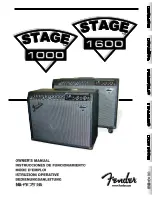
Glossary of Terms
__________________________________________________________
- 29 -
Line level
- Refers to the voltages used by audio devices such as mixers, signal processors, tape
recorders, and DAWs. Professional audio systems typically utilize line level signals of +4 dBM (which
translates to 1.23 volts), while consumer and semiprofessional audio equipment typically utilize line
level signals of –10 dBV (which translates to 0.316 volts).
Low shelving filter
- An equalizer circuit that cuts or boosts signal below a specified frequency, as
opposed to boosting or cutting on both sides of the frequency.
Makeup gain -
A control that allows the overall output signal to be increased in order to compensate
(“make up”) for the gain reduction applied by the compressor.
Memory effect
- In an electro-optical compressor, refers to the fact that it takes a certain amount of
time for the photo-cell to recover after light is removed, depending on how long light had been
shining on it and how bright the light was. Because of this, you can actually "train" the compressor’s
response characteristics by pre-rolling material for a minute or two, essentially saturating the photo-
cell.
Mic level
- Refers to the very low-level signal output from microphones, typically around 2 millivolts
(2 thousandths of a volt).
Mic preamp
- The output level of microphones is very low and therefore requires specially designed
mic preamplifiers to raise (amplify) their level to that needed by a mixing console, tape recorder, or
digital audio workstation (DAW).
Millisecond
(ms)
– A thousandth of a second.
Negative feedback
- Negative feedback is a design technique whereby a portion of the preamplifier’s
output signal is reversed in phase and then mixed with the input signal. This serves to partially
cancel the input signal, thus reducing gain. A benefit of negative feedback is that it both flattens and
extends frequency response, as well as reducing overall distortion.
Patch bay
- A passive, central routing station for audio signals. In most recording studios, the
line-level inputs and outputs of all devices are connected to a patch bay, making it an easy matter
to re-route signal with the use of patch cords.
Patch cord
- A short audio cable with connectors on each end, typically used to interconnect
components wired to a patch bay.
Panel aging -
More related to the amount of actual use rather than age in years, this is a phenomenon
which affects the threshold (and, to a lesser degree, attack time and release time) of an electro-
optical compressor. The more "aged" the EL panel, the greater the amount of gain reduction will need
to be applied. Panel aging is probably a major reason why the same model of electro-optical
compressor can sound subtly different between units.
Peak reduction -
A synonym for compression or limiting.





































